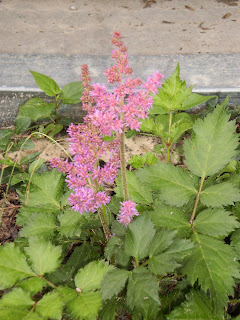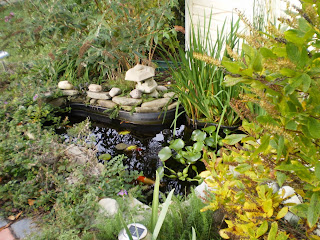
It's been that time in the late summer when I just cannot get excited about the garden. When we returned from vacation it was the hazy, hot and humid part of the Central Virginia summer and I just could not drag myself out to do anything. Fortunately, we have had a very wet summer and it has grown beautifully, so didn't need much from me except some spot watering - mostly the pots - and some weeding. I have managed a couple of early mornings at that, altho there is plenty left to do!
But there is something about the first of September and Labor Day that changes everything. Mitchell has said for years that fall may begin on the 21st, but the weather changes on Labor Day. More and more I think he's right. The last week has been in the low to mid-80's, which is a few degrees cooler than average, but we should remain in the mid-80's thru the end of the month, and the humidity has dropped noticibly in the past couple of days.

All of a sudden I'm starting to get in the mood to work outside again, and I find all sorts of signs of the fall plants getting ready to make their appearances. So, here's what's happening:
Sedum: There are two of the "tall" varieties blooming right now. 'Autumn Joy' (right) is one of the most familiar and found in many gardens. I transplanted mine to the xeri-garden I created this spring, so altho it is just starting to pink-up, it is not standing up. Normally, it would be 12 - 15 inches tall, but it is still lying down from the transplant. Next year, it will be fine, but this is a floppy year for it. As you can see, it's mostly still green, but there are a few pink petals already.
I discovered 'Madrona' (at the top) a few years ago and love it. The flower heads are a bit more rounded than 'Autumn Joy' which is rather flat, and it is currently a lovely pale rose color. As it matures it will darken and finally become a deep, dark rose that will eventually dry on the plant if I leave it that long. It provides good fall food for the birds, too.

The third sedum is 'Dragon's Blood' which is sort of tall and sort of creeping. Technically it's a "spreading" sedum, but its growth habit is very different from others. The plant has a basal growth habit like 'Madrona' and 'Autumn Joy', but the stems lie down and only the flower sits up. It makes a sort of circular mat overall. This one started blooming about a month ago, and is in its second flush of blooms. You can see how the new blooms are bright pink, while the older ones have already darkened.
We also have three creeping varieties of sedum, but only one is doing well right now. The 'Sea Stars' have struggled for years. They do not like wet feet, and since they are way less than an inch tall, that's tough when we have heavy rain. I have tried to move them to higher ground but, with basically a clay soil type, they are still struggling.
I have replaced most of my 'Sea Stars' with either 'John Creech' or 'Angelina' - bo

th of which were gifts from Garland. When she moved to North Carolina three years ago, I got some 'John Creech' (right) that piggybacked with the many perennials that she gave me. I really love the way it grows in whorls around a main stem, and it makes a great groundcover than can take being walked on. I have put it among stepping stones and it is beautiful. We lost a big patch of it while we were gone i

n August - so it either got way too dry, or more likely way too wet. The 'Angelina' was a gift this spring, and is a lovely new addition. It is a bit taller and looks a bit like an evergreen with tiny needles, and has a golden cast to the leaves. It didn't bloom this year, but it's still getting over the transplant, too. On the left you can see 'Angelina' in front of 'Sea Stars'.
I have read that there are more than 400 varieties of sedum, so I hope to explore a few more of them someday. I love the ones I have and they help bridge the gap from summer flowers to fall flowers. And, of course, so many of them are pink!
Xeri-garden: I could not have asked for a better result the first year of this garden - I love it. The agastache 'Ada' is magnificent, and it is not quite its full height this year! It is filled with bees and butterflies all day long and looks great against the fence. The evening primrose 'Shimmer' has started blooming again this week, and overall, the whole bed has filled in well. The white salvia

has bloomed all summer long, and so has the catmint. There are disappointments, of course. I lost two of the three creeping thymes and the sedum are still lying down, but there is so much promise for next year. I need to do some work on it this fall once everything dies back, tho.
The biggest mistake I made was in rushing to plant. I did not wait long enough for the soil to settle. [If you recall, I put the dirt in and planted the same day.] I should have let the soil sit for at least a week to compact. Unfortunately, it compacted after I planted, so now it has settled about six inches and I need to add soil to th

e entire bed. I am out of home-grown soil, so will need to buy a couple of bags of top soil and then add a couple of bags of organic matter. Then I will need to top dress around all the plants. Fortunately, most perennials will do okay with this treatment. Worst case, I will have to replant everything this fall. Either way, I should have a good result for next year.
This bed has been a great addition to the yard, tho. You see it as you come in the driveway and when you walk out either the side or back door, so we can enjoy it from many places.
And, a surprise: This is what gardening is all about. Many years ago I fell in love with alstroemeria. They are the backbone of flower arrangements all year long, and actually come from Africa [or so I have been told]. You often see the variety 'Laura' for sale,

but few others. I have 'Laura' which is a good solid yellow with darker markings, as well as 'Merry Christmas' which is green with red markings [duh!], but have looked pretty much in vain for other varieties for my garden. Two summers ago I discovered a pot of "Oxana Princess Lilies" at the big blue box store. Clearly they were alstromeria - Alstroemeria hybrid 'Staprioxa' to be exact - so I snarfed them up and planted them. And, they immediately died.
Well, all but one. This morning I discovered one little stem of the most gorgeous deep pink flowers. They live a long time indoors, so I believe that as soon as the sun is off of it, I shall cut it and bring it in to enjoy. Here it is for you to enjoy, too.
 t significant additional rain that week and the next, and now we have gotten more than 12 inches of snow. I've been in the garden exactly twice since before Thanksgiving - once to check on the fish nearly three weeks ago and again on Christmas Day in search for rosemary! I made a quick check on the fish then, too. They seem to be fine.
t significant additional rain that week and the next, and now we have gotten more than 12 inches of snow. I've been in the garden exactly twice since before Thanksgiving - once to check on the fish nearly three weeks ago and again on Christmas Day in search for rosemary! I made a quick check on the fish then, too. They seem to be fine.
 s summer. We didn't lose a lot of shrubbery in the snow. I was able to get out and uncover a lot of smaller things the first day. We have a lot of breakage in the nandinas, but they can be cut back hard in February and will fill out again quickly. And, it will be in the 50's again today so most of the rest of the snow should met, freeing us from an icy deck. And, I nearly forgot, I still have not had to cut the grass in the back yard!
s summer. We didn't lose a lot of shrubbery in the snow. I was able to get out and uncover a lot of smaller things the first day. We have a lot of breakage in the nandinas, but they can be cut back hard in February and will fill out again quickly. And, it will be in the 50's again today so most of the rest of the snow should met, freeing us from an icy deck. And, I nearly forgot, I still have not had to cut the grass in the back yard!














































